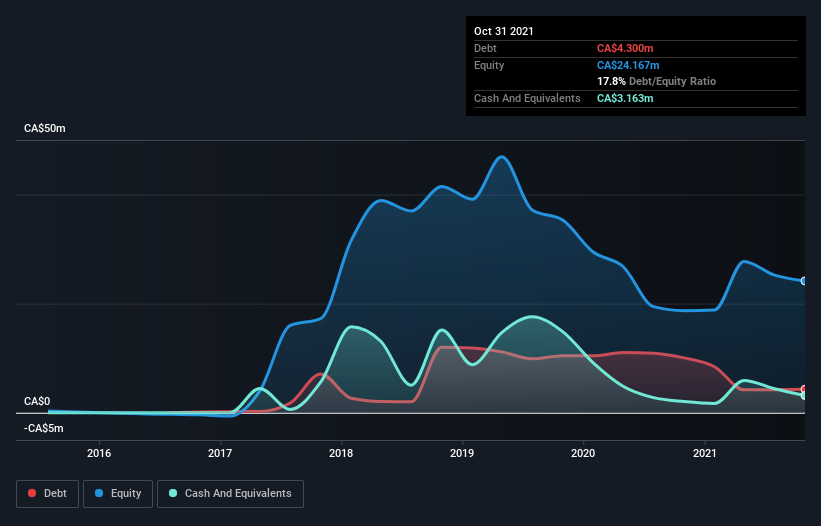Warren Buffett famously said, 'Volatility is far from synonymous with risk.' When we think about how risky a company is, we always like to look at its use of debt, since debt overload can lead to ruin. Importantly, 1933 Industries Inc. (CSE:TGIF) does carry debt. But should shareholders be worried about its use of debt?
Why Does Debt Bring Risk?
Debt assists a business until the business has trouble paying it off, either with new capital or with free cash flow. If things get really bad, the lenders can take control of the business. However, a more frequent (but still costly) occurrence is where a company must issue shares at bargain-basement prices, permanently diluting shareholders, just to shore up its balance sheet. By replacing dilution, though, debt can be an extremely good tool for businesses that need capital to invest in growth at high rates of return. When we examine debt levels, we first consider both cash and debt levels, together.
Check out our latest analysis for 1933 Industries
What Is 1933 Industries's Net Debt?
As you can see below, 1933 Industries had CA$4.30m of debt at October 2021, down from CA$10.1m a year prior. However, it also had CA$3.16m in cash, and so its net debt is CA$1.14m.

How Healthy Is 1933 Industries' Balance Sheet?
We can see from the most recent balance sheet that 1933 Industries had liabilities of CA$7.49m falling due within a year, and liabilities of CA$12.9m due beyond that. Offsetting these obligations, it had cash of CA$3.16m as well as receivables valued at CA$1.29m due within 12 months. So its liabilities total CA$16.0m more than the combination of its cash and short-term receivables.
This is a mountain of leverage relative to its market capitalization of CA$22.5m. Should its lenders demand that it shore up the balance sheet, shareholders would likely face severe dilution. When analysing debt levels, the balance sheet is the obvious place to start. But you can't view debt in total isolation; since 1933 Industries will need earnings to service that debt. So if you're keen to discover more about its earnings, it might be worth checking out this graph of its long term earnings trend.
Over 12 months, 1933 Industries reported revenue of CA$12m, which is a gain of 9.1%, although it did not report any earnings before interest and tax. We usually like to see faster growth from unprofitable companies, but each to their own.
Caveat Emptor
Importantly, 1933 Industries had an earnings before interest and tax (EBIT) loss over the last year. To be specific the EBIT loss came in at CA$2.0m. Considering that alongside the liabilities mentioned above does not give us much confidence that company should be using so much debt. Quite frankly we think the balance sheet is far from match-fit, although it could be improved with time. Another cause for caution is that is bled CA$4.8m in negative free cash flow over the last twelve months. So in short it's a really risky stock. The balance sheet is clearly the area to focus on when you are analysing debt. However, not all investment risk resides within the balance sheet - far from it. For instance, we've identified 3 warning signs for 1933 Industries (2 are a bit unpleasant) you should be aware of.
If, after all that, you're more interested in a fast growing company with a rock-solid balance sheet, then check out our list of net cash growth stocks without delay.
New: AI Stock Screener & Alerts
Our new AI Stock Screener scans the market every day to uncover opportunities.
• Dividend Powerhouses (3%+ Yield)
• Undervalued Small Caps with Insider Buying
• High growth Tech and AI Companies
Or build your own from over 50 metrics.
Have feedback on this article? Concerned about the content? Get in touch with us directly. Alternatively, email editorial-team (at) simplywallst.com.
This article by Simply Wall St is general in nature. We provide commentary based on historical data and analyst forecasts only using an unbiased methodology and our articles are not intended to be financial advice. It does not constitute a recommendation to buy or sell any stock, and does not take account of your objectives, or your financial situation. We aim to bring you long-term focused analysis driven by fundamental data. Note that our analysis may not factor in the latest price-sensitive company announcements or qualitative material. Simply Wall St has no position in any stocks mentioned.
About CNSX:TGIF
1933 Industries
Engages in the cultivation, extraction, and production of cannabis products in the United States.
Fair value with low risk.
Similar Companies
Market Insights
Community Narratives



